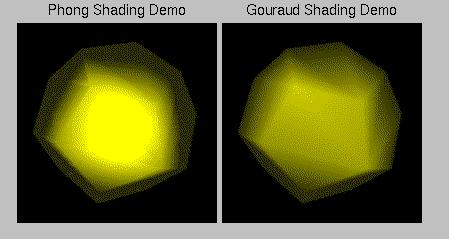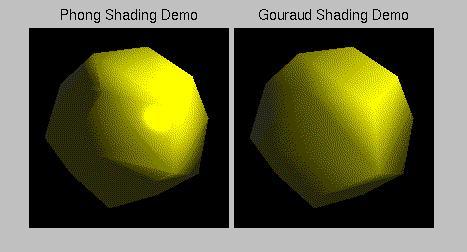Summary of 3 Shading Models
There are three traditional shading models, namely flat shading, Gouraud shading and Phong shading. Global illumination shading models such as recursive ray tracing and radiosity takes into account the interchange of light between all surfaces.
Flat Shading
Flat surface rendering or constant shading is the simplest rendering format that involves some basic surface properties such as colour distinctions and reflectivity. This method produces a rendering that does not smooth over the faces which make up the surface. The resulting visualization shows an object that appears to have surfaces faceted like a diamond.
Rendering only requires the computation of a colour for
each visible face. The whole face is
filled with this colour.
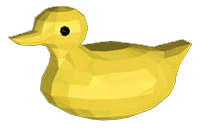
Toy duck using flat shading.
This approach is fast and very simple, but it gives quite unrealistic results and non-smooth surfaces. This is highlighted by the Mach effect: the intensity at the vicinities of the edges is overestimated for light values and underestimated for dark values.
Gouraud Shading
The Gouraud shading [Gouraud, 1971] is restricted to the
diffuse component of the illumination
model and it gives a fairly realistic result
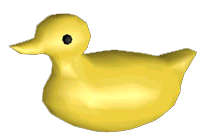
Toy duck usingGouraud shading.
It is noted that most VR systems, including Leeds Advanced
Driving Simulator and arcade
games such as Sega's Street Fighter, use Gouraud shading extensively.
Phong Shading
Phong shading overcomes the limitation of Gouraud shading
by incorporating specular reflection
into the scheme [Phong, 1975]. Now, we have the effect of specular highlight
in the middle of
each polygon. Also note that the intensity transition from one polygon to another
is smoother.
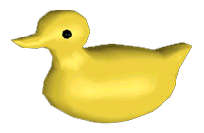
Toy duck using Phong shading.
However, the primary objective is for efficiency of computation
rather than for accurate physical simulation. As mentioned by Phong: "We
do not expect to be able to display the object exactly as it would appear
in reality, with texture, overcast shadows, etc. We hope only to display an
image that approximates the real object closely enough to provide a certain
degree of realism."
